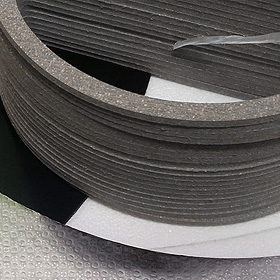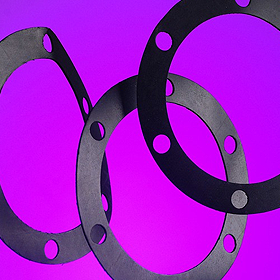
Proactive design methodologies manufacture gaskets from specially selected materials when chemical resistance is a major issue. Step back from the pipes and storage containers for a minute to see why this design principle is so important. Caustic compounds are coursing through these metal channels. They react aggressively with certain materials. How does a chemical resistance guide stop this aggressive reaction from weakening a gasket?
Modifying Gasket Properties
If seal technology can manufacture products that target heat extremes and intense pressure differentials, then that same know-how can produce seals that can handle different chemical families. Organic fuels and viscous lubricants adhere to this principle, as do acidic compounds. All that’s required is a technical specification sheet and an aptitude for expert material selection. The gasketing material is then manufactured from a chemically-neutral compound, a polymer or metal that won’t react with the conveyed fluid.
Chemical Resistance Counts
Unequivocally, the seals in a chemical line are beyond important. If corrosive chemicals leak because the wrong material has been selected for the joint seal, the escaping fluid could form a toxic cloud and poison the local environment. We’re dealing in “could’s” and “maybe’s” so far, but the damage will cause a catastrophe. At best, imagine the toxic fluid damaging the environment and getting into the local water supply. At worst, well, if the mix is combustible, then a catastrophic explosion will destroy everything in its path.
Determine Resistance
A sound understanding of material properties and the application domain are mandated. Compatibility reference charts are available from material sources, so use this resource before making a commitment to the project. For instance, PTFE holds a special place in a design engineer’s heart because of its chemically neutral structure, but it can weaken when it’s exposed to a fluorinating agent. This example only serves to prove the principles we’re stressing. In short, even the strongest material will fail when it meets its chemical “Kryptonite.” In conclusion, opt for a non-reactive gasket, but do realize that the term “non-reactive” is relative. Its reliability depends on the conveyed or stored chemicals and their reactive properties.
A seal, when compressed and pressed into service, should never be viewed as the weak link in the pipeline. Instead, it must be designed to excel. This challenging feat is made possible by installing the product properly and ensuring that it’s designed to endure, no matter the abrasive chemical within. Always evaluate the chemical resistance of gaskets when working with corrosive and toxic materials.

Intelligent design practices form the spearhead of any design process. In the case of the various materials used for making gaskets, fabrication development takes its lead from the eventual application. In essence, nothing is set in stone until certain important factors are determined. These client-stipulated specifications cover mechanical operating conditions and thermal factors, plus there’s the chemical composition of the interred fluid to consider.
Fluid Conveyance Deliberations
Volatile chemicals assault fluid transmission joints. Heat and pressure extremes then go to work on pipe seals and housings. They’re assisted by fastener pressure and half a dozen other compressive elements. Even water can be an unsolicited threat here when time works with the liquid to oxidize parts. Gaskets prevail in all of these scenarios when they’re made of the right material.
Moderately Capable
Various fabrics are used to manufacture the right seals for specific applications. They start on the most innocuous level with granulated cork and paper films. The substrate fabrics are not pressure rated, but they do resist oils and certain fuels. Cellulose-based paper, for example, is used in many low horsepower engines to repel oily substances and semi-viscous fuels. Cork variants also bind to rubber backings to add vibration compensating features to the mix.
Fabric and Foam
When used in their base form, there’s little to be said about the mechanical aptitude of this product. Nylon yarn and urethane linings are typically die cut into complex shapes. The weave incorporates conducting metals so that the finished fabric sheet can be used as an EM (electromagnetic) shield. Important as this electronics-oriented application undoubtedly is, the fabric only realizes its ultimate purpose when it’s paired with strong polymers.
Fabric-Reinforced Gaskets
Polyester and rayon are two of the more common woven threads in use on this occasion. They bind EPDM, Neoprene, and other chemically neutral polymers. In effect, the soft rubbers compress efficiently while the fabric stops flex cracks. It reinforces the polymer. This composite gasketing type is also known as a cloth inserted sheet.
The tip of our metaphorical spear is reserved for our concluding paragraph. The materials used here include high-end silicones and the polyurethane family. From here, the synthetically engineered materials divide further to include chemically resistant branded variants and Teflon-strengthened PTFE. Finally, crowning these elastomeric and pliable synthetics, comes spiral wound gaskets. They sit up top with metal gaskets, alloys that are relatively soft but require immense compressive force if a proper seal is to be achieved.

Gasket fabrication technology produces reams of high-quality joint seals, but they’re not exactly designed to be dimensionally precise. After all, their primary function is to create an unbreakable seal, not to advance some difficult-to-achieve structural ideal. Of course, this idealised form is available, but only compression controlled gaskets can properly foster such accurate outlines when extreme tightening forces are doing their utmost to corrupt a gasket’s dimensionally assured outlines.
What are Compression Controlled Gaskets?
This sealing medium compresses intelligently when fastening forces exert great force on a joint. In other words, the gasket spreads smartly when it’s sandwiched between two sealing faces. Imagine the benefits of this non-compressible material. It won’t spread beyond the boundaries of delineated gasket space, so no untidy edges are exposed to the internal or external pipe joint. This is an especially handy feature when internal flow conditions are sensitive to material interference.
Flush Unions Support Sensitive Fluid Conditions
As the gasket lays flush at the joint union point, no “dead spots” will form. Instead, the fluid is conducted smoothly from one pipe section to the next. This singular flow-smoothening characteristic is viewed as highly important in certain applications. Subsequently, the food and pharmaceutical industry both employ compression controlled gaskets because system engineers are upholding a regulated hygiene methodology. Basically, the addition of an intersection aid that creates a seamless seal serves to reinforce hygiene-centric design practices.
Creates Extrusion-Free Unions
A vulcanised Ultem resin regulates the compression force applied by mechanical fasteners. The gasket material within the ring of non-compressible resin then conforms to the ferrules of the mechanical bore juncture to form a flush interface, an uninterruptible bridge between system-critical fluid channels. The design is recognized as a perfect fit for sanitary-sensitive applications, so it’s found in conduits that carry foodstuffs and beverages. Likewise, many chemical and medical fields employ the gasket when seeking to eliminate the inline dead spots that could provide shelter for bio-contaminants. Interestingly, the lifespan of this sealing product is also extended by its flattened profile, for no stray edges are protruding into the flow, so the gasket doesn’t wear as quickly as general-purpose sealing products.
These are specialised gaskets. They’re designed to excel in situations where dimensional accuracy is a major asset. A tabbed kit takes sanitary considerations to the next logical feature plateau by ensuring finger contact is minimised. All handling and installation work is done via the tabs, all so that a hygiene-oriented union is fully realised.